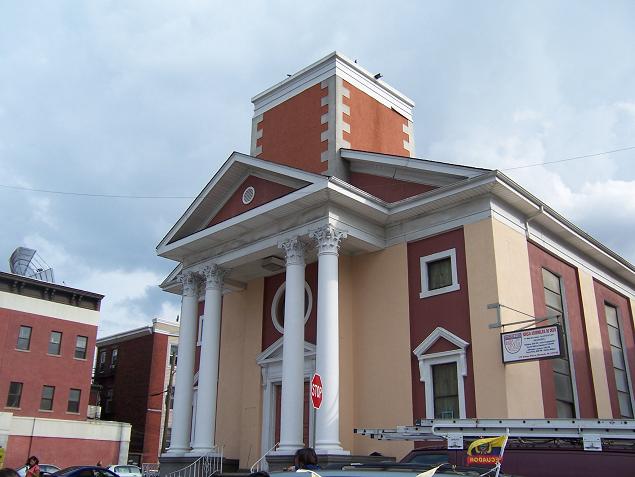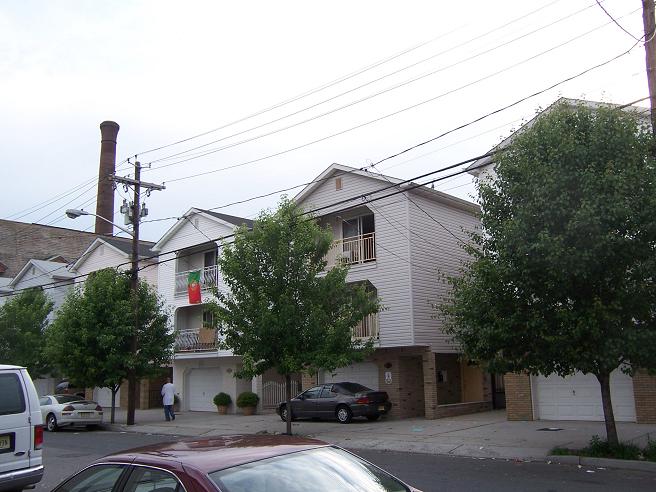|
McWhorter Street was named after the Rev. Dr. Alexander McWhorter, the Scotch-Irish pastor of the Old First (Presbyterian) Church. McWhorter was a supporter of the American Revolution, a historian of Newark, and the organizer of Newark's first July 4th parade, held back in 1788.
|
 |
|
 |
One of many fascinating examples of ethnic succession in the Ironbound is this 1848 Second Dutch Reformed Church, then, Our Lady of Mt. Carmel, now an Evangelical Protestant congregation. This church formerly had a tall steeple, but the steeple was removed after World War II. The building became Our Lady of Mt. Carmel in 1890 and was one of the first parishes in Newark to serve Italians. Mother Frances Xavier Cabrini herself, the first American citizen to be canonized, operated a school in the basement here.
|
|
| The Ironbound is one of the most soccer mad neighborhoods you'll find anywhere in the United States. I did this tour on opening night of the world cup, if people weren't carrying flags, they were wearing them as capes or displaying them on the hoods of their cars.
This fan was carrying Portuguese and Ecuadoran flags. She herself was Portuguese, her sister's boyfriend was Ecuadoran.
|
 |
|
 |
This is Hamilton Street, one of the last brick streets in Newark. (another brick street is North End, which was featured in On Broadway).
In Phillip Roth's American Pastoral Merry Levov, a 1960s terrorist, eventually renounces all violence, becomes a Jain, and settles here on Hamilton Street.
The right of way for the old Jersey Central Railroad was immediately north of here.
|
|
| This old chocolate factory at the intersection of Hamilton and McWhorter has been beautifully converted to apartments. |
 |
|
 |
McWhorter Street plays a large role in the Ironbound's Portuguese history.
|
|
|
Most of the Portuguese in Newark immigrated in the 1950s or after, yet, the Ironbound has had a substantial Portuguese presence since the 1910s/1920s, when Portugese immigrants fled the declining shoe industry in New England to find work in booming industrial Newark.
91 McWhorter Street was the home of Dan and Elvira Rodrigues, "the Mayor and Mayoress of McWhorter Street." Daniel "Albino" Rodrigues came to Newark in 1925 at age 23 from Portugal by way of the Brooklyn docks and the rubber industry of Brazil. He and Elvira ran Dan's Friendly Oil Service in the Ironbound. They built this house themselves in 1946 and lived here until they died in the 1980s.
Dan and Elvira were very community spirited. In 1959 Dan and Elvira set sail for Portugal carrying 66 trunks of clothing for the poor. Elvira was active in the Democratic party, registering thousands of new Americans as first time voters. Dan was a trustee of the Newark Public Library.
|
|
|
 |
These townhouses were built on former industrial land. The old Murphy Varnish Works used to occupy several blocks. These houses may have been built on former varnish factory property. |
|
| This is what apartment houses in the Ironbound looked like before the present rowhouse boom. This particular house has benefitted from some recent repainting and tuckpointing. |
 |
|
 |
An ad for Owl Cigars. Look carefully on the right side of the wall to see the outline of an owl. In my last Ironbound street feature, Fleming Avenue, I saw an old ad for Hassan Cigarettes, "the Oriental Smoke." |
|
|
The highlight of McWhorter Street is the factory of the old Murphy Varnish Company, mentioned in our previous feature on the Weequahic Park Franklin Murphy Statue.
Franklin Murphy's father gave his son a half-share in a weakly profitable varnish company shortly after the younger Murphy came home from the Civil War. Murphy emphasized a quality product and soon found himself running a profitable business. Before Franklin Murphy went into business, Americans seeking high-quality varnish had to import it from England.
|
 |
|
 |
Thanks to Franklin Murphy, a whole paint/lacquer/varnish industry sprang up in the Ironbound. Benjamin Moore paints is still here, but Sherwin Williams, Beckwirth-Chandler, Cook and Dunn, Flood and Conklin, Maas and Waldstein, Security Paint and Varnish, Vita-Var, Duralock Chemical Corp., and Tribault and Walker have left. (Cummings, Sept 19, 1996)
The Murphy Varnish Company constructed these buildings in the 1880s, 1890s, and 1900s. The main building, shown here, was designed by Howard Chapman. Like the quality he put into his varnish, Franklin Murphy clearly wanted to put quality into his factory buildings.
|
|
|
The Murphy Varnish Company closed in 1950. Afterwards, it was the Rambach Chemical Storage facility. The site is on the National Register of Historic Places and the Newark Landmarks Conservancy's list of historic Newark places. Its fate is uncertain.
My favorite touch from the Murphy Varnish Company factory is this bas-relief symbolizing delivery, where a chariot driver carries a barrel of the M.V., the Murphy Varnish. This was the logo of the Murphy Varnish Company. |
|

|
|
 |
At the end of the tour we come to Firehouse # 14, at McWhorter and Vesey, still in operation. This colorful building was built in 1898. It is one of two Nineteenth century firehouses still in use in Newark. The other one is Engine 15/Truck 7 at 269 Park Ave.
|
|

